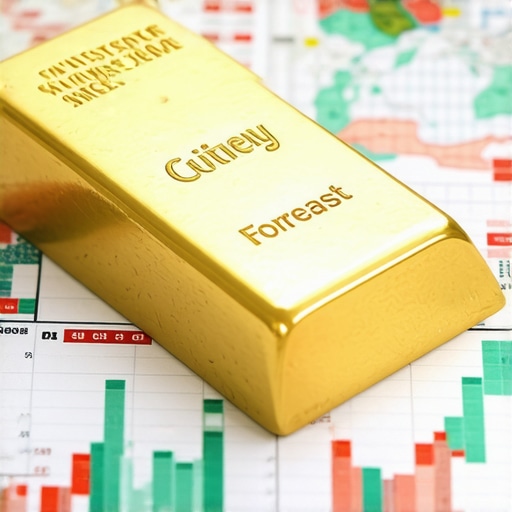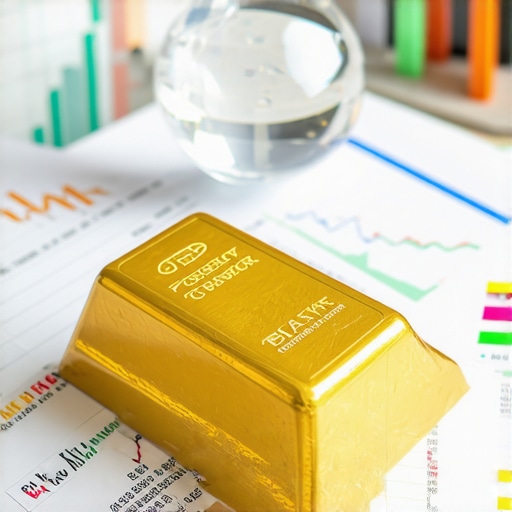Understanding the Relationship Between Inflation and Gold Prices
Inflation has long been a crucial factor influencing various investment markets, particularly gold. Investors often turn to gold as a hedge against inflation, seeking to preserve their wealth during economic downturns. But how exactly does inflation impact gold prices? In this article, we delve into the intricate relationship between inflation and gold, emphasizing its significance for investors.
Why is Gold Considered a Hedge Against Inflation?
Gold has been viewed as a store of value for centuries. When inflation rises, the purchasing power of currency tends to decline, which can lead investors to seek tangible assets like gold. Unlike fiat currencies, which can be printed in unlimited quantities, gold is a finite resource. This scarcity tends to increase its value during inflationary periods.
Research indicates that gold has historically maintained its value even as prices of goods and services rise. According to the Investopedia, the correlation between gold prices and inflation rates is significant, making it a safe-haven asset for investors looking to mitigate the risks posed by inflation.
How Does Inflation Affect Gold Demand?
As inflation rises, so does the demand for gold. Investors often flock to gold as a protective measure against eroding purchasing power. This increased demand can lead to a surge in gold prices. For instance, during periods of high inflation, such as the 1970s, gold prices soared as investors sought refuge from declining currency values.
What Economic Factors Influence Gold Prices During Inflation?
Several economic indicators can influence gold prices in relation to inflation:
- Interest Rates: Typically, when inflation rises, central banks may increase interest rates to combat it. Higher interest rates can lead to lower gold prices, as gold does not yield interest.
- Currency Strength: A weakening currency can push gold prices higher, as it takes more of that currency to purchase the same amount of gold.
- Global Economic Stability: Economic instability often drives investors to gold as a safe haven, increasing demand and consequently raising prices.
In summary, the interplay between inflation and gold prices is complex and influenced by multiple factors. Understanding these dynamics is vital for any investor looking to navigate the gold market successfully.
As we move into an era where inflationary pressures may persist, keeping an eye on gold investment strategies becomes essential. For those interested in delving deeper, check out our article on how inflation impacts gold demand and trading strategies.
Have you considered gold as part of your investment strategy? Share your thoughts in the comments below!
The Role of Economic Indicators in Gold Price Movements
Economic indicators play a vital role in determining gold prices, especially during inflationary periods. Investors should closely monitor key indicators such as consumer price index (CPI) and producer price index (PPI), which provide insights into inflation trends. A rise in these indicators often signals increasing inflation, which can lead to a surge in gold demand as investors look for safe-haven assets.
How Do Geopolitical Events Affect Gold Prices During Inflation?
Geopolitical events can significantly influence gold prices, particularly during times of inflation. For instance, uncertainty arising from conflicts or political instability can drive investors to gold, further increasing its value. The Wikipedia outlines how gold historically thrives during periods of global uncertainty, making it a reliable investment during inflationary times.
Moreover, central banks often adjust their gold reserves in response to geopolitical tensions, further impacting gold prices. When countries face economic instability, they may increase their gold holdings, which can create upward pressure on prices.
Investor Sentiment and Gold Prices
Investor sentiment plays a crucial role in gold pricing. During inflationary periods, fear and uncertainty can drive retail and institutional investors toward gold, resulting in increased prices. The psychological aspect of investing cannot be overlooked; when the market is volatile, gold is perceived as a secure store of value.
Another factor contributing to this sentiment is the historical performance of gold during inflationary periods. As noted in various studies, including those published by financial analysts, gold has consistently outperformed other asset classes during high inflation, reinforcing its reputation as a hedge.
What Strategies Can Investors Use to Protect Against Inflation?
Investors looking to protect their portfolios from inflation should consider diversifying their investments with gold. Incorporating gold ETFs or physical gold into their asset mix can provide a buffer against economic downturns. Additionally, staying informed about market trends and adjusting their strategies accordingly is essential for maximizing returns.
For those interested in exploring gold investment strategies, our article on the benefits of investing in gold ETFs in 2025 provides valuable insights.
What are your thoughts on gold as a hedge against inflation? Join the conversation in the comments below!
Investor Sentiment and Gold Prices
Investor sentiment plays a crucial role in gold pricing, particularly during inflationary periods. Emotional responses to market conditions can heavily influence decisions, prompting a surge in demand for gold as a safe haven. When uncertainty prevails, whether due to economic downturns or geopolitical conflicts, gold often becomes an attractive asset for both retail and institutional investors.
How Does Investor Behavior Affect Gold Prices?
The psychology of investing cannot be underestimated. During challenging economic times, fear and anxiety can drive investors towards gold, leading to an increase in prices. Historical performance data supports this trend, showing that gold consistently outperforms other asset classes during high inflation periods. According to a report by the Investopedia, gold’s ability to maintain its value during inflationary periods reinforces its reputation as a hedge against economic instability.
Moreover, the behavior of institutional investors can amplify these effects. Large purchases by hedge funds or mutual funds can significantly drive up gold prices, particularly in response to negative market sentiment. As these entities adjust their portfolios, their actions can create a ripple effect, influencing retail investor behavior and leading to broader market shifts.
Geopolitical Factors Impacting Gold Prices
Geopolitical events also play a vital role in gold price movements. Political instability, conflicts, or trade tensions can prompt investors to turn to gold as a protective asset. For instance, when tensions rise in regions like the Middle East or Eastern Europe, demand for gold often spikes as investors seek refuge from potential economic fallout. This trend highlights gold’s status as a reliable investment during uncertain times.
What Are the Key Economic Indicators to Monitor for Gold Investment?
To effectively navigate gold investments, investors should monitor key economic indicators that reflect broader market conditions:
- Consumer Price Index (CPI): A significant rise in CPI indicates increasing inflation, often leading to heightened demand for gold as a hedge.
- Interest Rates: Central banks typically raise interest rates to combat inflation, which can affect gold prices negatively since gold does not yield interest.
- Global Economic Stability: Economic downturns or instability often result in increased gold demand as investors seek safety.
By keeping a close eye on these indicators, investors can develop more informed strategies regarding their gold investments.
Exploring Investment Strategies with Gold
Investing in gold can take various forms, from physical gold to gold ETFs. Each method has its unique advantages and risks. Gold ETFs, for instance, provide a way to invest in gold without the need for physical storage, making them a convenient option for many investors. However, understanding the nuances of each investment type is crucial for maximizing returns.
For detailed insights into effective gold investment strategies, consider reading our article on effective gold trading techniques.
What are your thoughts on the impact of investor sentiment on gold prices? Join the conversation in the comments below!
Understanding Gold Investment Strategies During Inflationary Times
Investing in gold during times of inflation requires a strategic approach. As inflation erodes purchasing power, the demand for gold typically increases, making it essential to understand different investment strategies. Whether you prefer physical gold, gold ETFs, or mining stocks, each option offers unique benefits and risks. In this section, we will explore various gold investment strategies that can help you navigate the tumultuous waters of inflation.
What Are the Best Gold Investment Options for Inflation Protection?
When considering gold investments, you have several choices:
- Physical Gold: Holding physical gold, such as coins or bars, allows investors to possess a tangible asset. This can be an effective way to hedge against inflation, as gold typically retains its value over time.
- Gold ETFs: Gold exchange-traded funds (ETFs) offer a convenient way to invest in gold without the need for physical storage. They track the price of gold and can be traded like stocks, making them accessible for many investors.
- Gold Mining Stocks: Investing in gold mining companies can provide leveraged exposure to gold prices. When gold prices rise, mining stocks often outperform the commodity itself. However, they come with their own set of risks related to operational performance and management decisions.
Each of these options has its advantages and potential pitfalls, so it’s vital to assess your investment goals and risk tolerance before committing to any one strategy.
Analyzing Market Trends for Gold Investments
Staying informed about market trends is crucial for making sound investment decisions. Economic indicators such as inflation rates, interest rates, and geopolitical events can significantly impact gold prices. For instance, a rise in inflation often leads to an increase in gold prices due to heightened demand.
Additionally, analyzing historical trends can provide insights into how gold has reacted in similar situations. According to a study by the World Gold Council, gold historically performs well during inflationary periods, making it a valuable asset for long-term investors.
How Can Investors Mitigate Risks Associated with Gold Investments?
While gold can be a robust hedge against inflation, it is not without risks. To mitigate potential downsides, consider the following strategies:
- Diversification: Incorporate a mix of gold investments within your portfolio, including physical gold, ETFs, and mining stocks. This can help spread risk and enhance potential returns.
- Regular Monitoring: Keep track of market trends and economic indicators that influence gold prices. Adjust your investment strategy accordingly to maximize returns.
- Long-term Perspective: Gold is often viewed as a long-term investment. Avoid making impulsive decisions based on short-term market fluctuations.
By implementing these strategies, investors can better position themselves to benefit from gold as an inflation hedge. For more insights on effective gold trading techniques, check out our article on top gold trading techniques for successful investing.
Final Thoughts on Investing in Gold Amid Inflation
Gold remains a compelling investment choice during inflationary periods. By understanding the dynamics of the gold market and employing smart investment strategies, you can effectively navigate the challenges posed by rising prices. Whether you opt for physical gold, ETFs, or mining stocks, the key is to stay informed and make decisions that align with your financial goals.
Have you incorporated gold into your investment strategy? Share your experiences and thoughts in the comments below!
Frequently Asked Questions (FAQ)
1. How does inflation affect gold prices?
Inflation generally leads to increased gold prices as investors seek gold as a safe haven to protect their purchasing power. When inflation rises, the value of currency decreases, prompting more people to buy gold, which can drive its price up.
2. What are the best gold investment strategies during inflation?
The best strategies include diversifying investments across physical gold, gold ETFs, and gold mining stocks. Each option offers unique advantages and can provide a hedge against inflation.
3. Can gold lose value during inflation?
While gold typically retains its value during inflationary periods, it is still subject to market fluctuations. External factors like interest rates and geopolitical events can influence gold prices, leading to potential short-term losses.
4. Should I invest in physical gold or gold ETFs?
Choosing between physical gold and gold ETFs depends on your investment goals. Physical gold provides tangible assets, while ETFs offer ease of trading and no storage concerns. Assess your risk tolerance and preferences before deciding.
5. How can I protect my gold investments from market volatility?
Diversification is key. By holding a mix of physical gold, ETFs, and mining stocks, you can mitigate risks. Regularly monitoring market conditions and adjusting your strategy can also help safeguard your investments.
6. What economic indicators should I watch for gold investments?
Important indicators include the Consumer Price Index (CPI), interest rates, and global economic stability. These factors often signal trends that directly impact gold prices.
7. What is the historical performance of gold during inflation?
Historically, gold has performed well during inflationary periods, maintaining or increasing in value when the purchasing power of currencies declines. This trend solidifies gold’s reputation as a reliable hedge against economic instability.
8. How often should I review my gold investment strategy?
Regular reviews, at least quarterly or during significant market shifts, are advisable. Staying informed about economic trends and adjusting your strategy can enhance your investment success.
9. What are the risks associated with gold investments?
Risks include market volatility, storage and insurance costs for physical gold, and operational risks for mining stocks. Understanding these risks is crucial for effective gold investment management.
10. How can I get started with gold investments?
Begin by researching different types of gold investments, such as coins, bars, ETFs, and mining stocks. Consider your financial goals and risk tolerance, and consult a financial advisor if necessary.
Authoritative Sources
1. Investopedia – A trusted source for financial education, providing insights on gold investment strategies and market trends.
2. World Gold Council – Offers in-depth research and reports on gold demand trends, market analysis, and investment strategies.
3. CNBC – A leading financial news network that covers global economic developments affecting gold prices and investment opportunities.
4. Bloomberg – Provides comprehensive market data and analysis on gold and other commodities, helping investors make informed decisions.
Conclusion
Investing in gold presents a compelling opportunity, especially during inflationary periods. As we’ve explored, understanding the dynamics of gold prices and employing effective investment strategies can help you navigate economic uncertainties. Whether you choose physical gold, ETFs, or mining stocks, the key is to stay informed and adapt your approach to align with your financial goals. Have you considered how gold can enhance your investment portfolio? Engage with us in the comments below and share your thoughts!










I’ve always been intrigued by how gold acts as a refuge during periods of inflation, and this article really clarifies why that is. The aspect that stands out to me is how gold’s scarcity contrasts with fiat currencies, which can be printed endlessly. This intrinsic limitation gives gold its lasting value, especially during times when inflation erodes currency purchasing power. I also find it interesting how economic indicators like CPI and interest rates can impact gold prices differently—especially how rising interest rates to curb inflation can sometimes negatively affect gold prices despite inflation rising. In my experience following the market, geopolitical instability seems to amplify demand for gold even more than economic indicators alone. I’m curious, though, how others balance the timing of gold investments when these conflicting factors are simultaneously at play. Do you prioritize geopolitical cues over economic data, or vice versa, when deciding to buy gold? Also, given the risks mentioned about gold investment types, how do you personally diversify your gold portfolio to balance convenience, cost, and security? I’d love to hear how others approach these challenges in their strategies.
This article provides a valuable overview of how inflation influences gold prices and highlights the importance of economic indicators, geopolitical events, and investor sentiment. From my personal experience, I’ve noticed that during periods of rising inflation, not only does gold demand surge, but the way investors interpret signals like CPI or geopolitical tensions can vary greatly depending on the broader economic context. For instance, I’ve found that when interest rates go up to combat inflation, gold prices sometimes dip temporarily, which can be confusing for novice investors. Wouldn’t you say that understanding the timing of these indicators is crucial for making optimal gold investment decisions? I also believe that diversifying with physical gold and ETFs offers some balance when navigating volatility. Has anyone else experienced a situation where geopolitical tensions didn’t translate into immediate gold price increases? I’d love to hear how different investors weigh these factors when planning their gold strategies, especially during prolonged inflationary episodes.